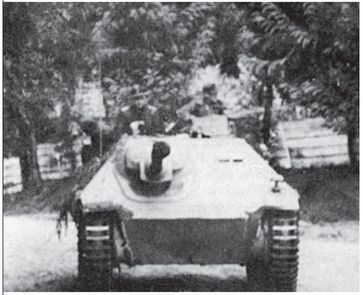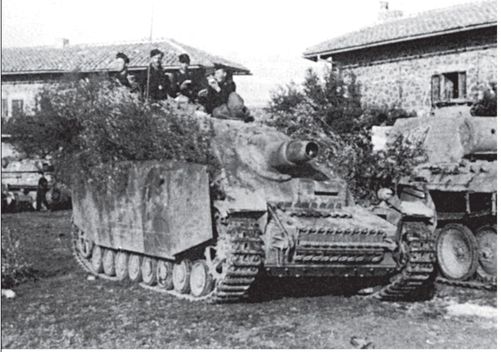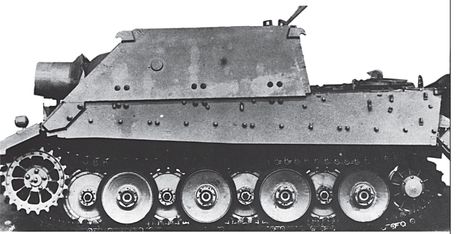Authors: Norbert Bacyk
Warszawa II (28 page)
Description: Regarded by many as the war's best mediumheavy tank, the Russians chose to classify it as a heavy tank. Originally set into production in 1942 as a solution the Soviet T-34, it was the first German tank with effectively sloped armour. Its design was complicated and it was often taken out of action, beset with problems in its hydraulic, gear-change, and wheel mounting systems. In the hands of well-train tank personnel, it was a life-threatening weapon even to the crews manning the allies' heaviest tanks. Fortunately, “Panthers” were never produced in sufficient number to meet the Germans' needs. All told, 3,750 variation G tanks were produced. And the combined production total for all variations was 6,100 Panthers.

Production period:
1943 â 45
Manufacturer:
MAN, MNH, Daimler- Benz
Tonnage:
45 tonnes.
Crew:
5
Length:
6.88 metres
Width:
3.40 metres
Track width:
66 cm
Clearance:
54 cm
Motor:
Maybach HL 230 P 30 V-12
Engine capacity:
700 HP at 3000rpm
Fuel capacity:
730 litres
Maximum speed:
46 km/h
Maximum range:
200 km
Armament:
1 Ã 7.5 cm KwK 42L/70
2 Ã 7.92 mm MG 34
1 Ã 7.92 mm MG 42
Ammunition quantity:
7.5 cm 80 shells
7.92 mm â 4,200 â 4,800 rounds
Armour strength:
Hull frontal:
60 â 80 mm
Hull sides:
40 â 50 mm
Hull back, roof, floor:
16 â 40 mm
Turret front:
100 â 110 mm
Turret sides:
45 mm
Germany's most important tank during the entire war, along with being the most produced. Blueprinted before the war, its more traditional square appearance was kept throughout the war. In terms of its weaponry and armour protection, they were upgraded constantly and while this caused the weight of the vehicle to increase, its engine performance did not and its overall manoeuvrability consequently suffered. By the end of the war, the development of most allied tanks had surpassed and outclassed the model in terms of both armaments and protection. However, there was no alternative available in sufficient number to replace the tank with the German army. In addition, the chassis was used as the basic platform for a flood of special vehicles and variations of weaponry, for example, the Brummbär and the Jagdpanzer IV, etc. Altogether, 5,400 examples of both variations were ultimately manufactured.

Production period:
1942 â 45
Manufacturer:
Steyr, Vomag, Krupp, Praga
Tonnage:
22.3 â 25 tonnes.
Crew:
5
Length:
5.93 metres
Width:
2.88 metres
Height:
2.68 metres
Track width:
40 cm
Ground clearance:
40 cm
Motor:
Maybach HL 120
TR V-12 Petrol
Engine capacity:
300 HP at 3,000 rpm
Fuel capacity:
453 litres
Maximum speed:
32 km/h
Maximum range:
250 km
Armament:
1 Ã 7.5 cm Kwk L/48
(G,H), 2 Ã 7.92 mm MG
Ammunition quantity:
7.5 cm â approx. 90 shells
7.92 mm â 3,600 rounds
Armour strength:
Hull frontal:
50 â 80 mm
Hull sides:
30 â 50 mm
Hull back, roof, floor:
15 â 25 mm
Turret front:
50 â 80 mm
Turret sides:
30 â 50 mm

Italy's most vital tank and the model they produced the most examples of. Typically, the Germans seized all functioning models of the tank as well as all functioning Italian transportation, on their capitulation in 1943. The Germans gave the tank their own id-number and used them as German Police tanks in the occupied territories: As a combat threat, the vehicle was insufficiently armed and the armour plating was designed for conditions in 1938/39 â Mechanically, they were unreliable and, in addition, the Germans lacked spare parts for them for obvious reasons. The M13/40 was the 1940 model, and likewise, the M14/41, the 1941model. The 1942 version, the M15/42, had hardly any production time before Italian capitulation.
Production period:
1940 â 1943
Manufacturer:
Ansaldo-Fossati
Tonnage:
14.3 tonne
Crew:
4
Length:
4.92 meter
Width:
2.23 meter
Height:
2.39 meter
Track width:
26 cm
Ground clearance:
40 cm
Motor:
SPA TM40 8-cylinders Diesel
Engine capacity:
125 HP at 1800rpm
Fuel capacity:
- liter
Maximum speed:
32 km/h
Maximum range:
200 km
Armament:
1 Ã 4.7 cm Model 37/32
Ansaldo:
3 Ã 8 mm
Breda MG model 38
Ammunition quantity:
4.7 cm â 108 shells, 8 mm â 3048 rounds
Armour strength:
Hull frontal:
25 â 45 mm
Hull sides:
25 mm
Hull rear, roof, floor:
15 mm
Turret, front:
25 mm
Turret sides:
25 mm

Germany's most produced special purpose AT (All-terrain) vehicle, or self-propelled, so-called “Armoured hunter.” Ironically enough, they were built on a chassis from Czechslovakia, and stretching this irony even further is the fact that it was the Czechs who succeeded in producing them great quantity and not the Germans,
It had a very simple and robust design, which even came to be used by the Swiss Army after the war. A low silhouette, relatively good armour protection and a reliable main gun, but above all, it was the ease of its operation that made it popular amongst the troops. In total, some 2,700 Hetzers were built between the summer of 1944 and the cessation of the war.
Production period:
1944 â 1945
Manufacturer:
Praga CKD, BMM, Skoda
Tonnage:
16 tonnes
Crew:
4
Length:
4.87 meters
Width:
2.63 meters
Height:
2.17 meters
Track width:
35 cm
Ground clearance:
42 cm
Motor:
Praga AC/2800 V-6 Bensin
Engine capacity:
160 HP at 2800rpm
Fuel capacity:
320 liters
Maximum speed:
42 km/h
Maximum range:
260 km
Armament:
1 Ã 7.5 cm PaK 39 L/48 cm
1 Ã 7.92 mm MG
Ammunition quantity:
7.5 cm â 42 shells
7.92 mm â 600 rounds
Armour strength:
Hull front:
60 mm
Hull sides:
25 mm
Hull rear, roof, floor:
25 mm

Description: The predecessor of the Sturmtiger. Modelled on the Pz Kpfw IV and was armed with a 15 cm StuH L/12. Actually highly successful as it could also be used for indirect artillery support for infantry forces. Over 300 were manufactured.
Production period:
1943 â 1945
Manufacturer:
Deutsche Eisenwerke
Tonnage:
28 tonnes
Crew:
5
Length:
5.93 meters
Width:
2.88 meters
Height:
2.52 meters
Track width:
40 cm
Ground clearance:
40 cm
Motor:
Maybach HL 120 TRM V-12 Bensin
Engine capacity:
300 HP at 3000 rpm
Fuel capacity:
470 liters
Maximum speed:
40 km/h
Maximum range:
180 km
Armament:
1 Ã 15 cm StuH L/12
1 Ã 7.92mm MG
Ammunition quantity:
15 cm â 38 shells
7.92mm â 600 rounds
Armour strength:
Hull frontal:
100 mm
Hull sides:
50 mm
Hull rear, roof, floor:
25 mm
A variation on the renowned Tiger. Behind its reinforced armour was installed a massive 38 cm howitzer which fired 344 kg shells. Partly due to experience gained from the battle for Stalingrad, the Germans knew that offensive warfare in an urban environment required powerful weapons to obliterate buildings constructed of concrete and stone. The Sturmstiger could solve this problem thanks to its massive armament. The only problem was that, at that point in time, the Germans didn't need massive offensive weapons for urban warfare, quite the opposite. As a result, only eighteen were ever manufactured.

Production period:
1943 â 1944.
Manufacturer:
Alkett
Tonnage:
66 tonne
Crew:
5
Length:
6.28 meters
Width:
3.57 meters
Height:
2.85 meters
Track width:
80 cm
Ground clearance:
48 cm
Motor:
Maybach HL230 P 45 V â 12 Bensin
Engine capacity:
700 HP 3000 rpm
Fuel capacity:
860 liters
Maximum speed:
40 km/h
Maximum range:
120 km
Armament:
1 Ã 38 cm Raketenwerfer 61
1 Ã 7.92 mm MG 1
Ammunition Quantity
:
60 cm â 14 shells
7.92 mm â 600 rounds
Armour strength:
Hull frontal:
150 mm
Hull sides:
80 mm
Hull rear, roof, floor:
40 mm
Turret front:
150 mm
Turret sides:
80 mm

